The Satyr and the Traveller

The Satyr and the Traveller (or Peasant) is one of Aesop's Fables and is numbered 35 in the Perry Index. The popular idiom 'to blow hot and cold' is associated with it.
The Fable
There are Greek versions and a late Latin version of the fable by Avianus. In its usual form, a satyr or faun comes across a traveller wandering in the forest in deep winter. Taking pity on him, the satyr invites him home. When the man blows on his fingers, the satyr asks him what he is doing and is impressed when told that he can warm them that way. But when the man blows on his soup and tells the satyr that this is to cool it, the honest woodland creature is appalled at such double dealing and drives the traveller from his cave. There is an alternative version in which a friendship between the two is ended by this behaviour.
The idiom 'to blow hot and cold (with the same breath)' to which the fable alludes was recorded as Ex eodem ore calidum et frigidum efflare by Erasmus in his Adagia (730, 1.8.30).[1] Its meaning was further defined by the emblem books of the Renaissance, particularly those that focused on fables as providing lessons for moral conduct. While Hieronymus Osius tells the tale of the traveller and draws the moral that one should avoid those who are inconstant,[2] Gabriele Faerno puts it in the context of friendship and counsels that this should be avoided with the 'double-tongued' (bilingues).[3] In this he is followed by Giovanni Maria Verdizotti,[4] Marcus Gheeraerts the Elder[5] and Geoffrey Whitney.[6] However, in Francis Barlow's edition of the fables (1687), the Latin text warns against those whose heart and tongue do not accord, while Aphra Behn comments in English verse that
- The sycophant with the same breath can praise
- Each faction and what’s uppermost obeys,[7]
following John Ogilby's slightly earlier example of giving it a political interpretation. The Wenceslas Hollar print in that edition emphasises the lesson by showing the battle in heaven and the fall of Lucifer as taking place outside the mouth of the cave in which the traveller is blowing on his broth.
The fable was included as Le satyre et le passant among the fables of Jean de la Fontaine (V.7)[8] but with no alteration of moral. However, this version too was to be reinterpreted in a political sense in the 19th century. In the course of his very free version, John Matthews expanded the text to comment on the 1819 election in Westminster and advise the voters to adopt the satyr's view of blowing hot and cold.[9] In France the satirical cartoonist J.J. Grandville also updated the meaning by showing a group of loungers reading and commenting on the newspapers in a public park next to a statue illustrating the fable (see in Gallery 4 below).
The Age of Enlightenment had intervened and prominent thinkers had then attacked the logic of this fable in particular. In the article on "Fable" in his Dictionnaire Philosophique (1764), Voltaire remarked that the man was quite right in his method of warming his fingers and cooling his soup, and the satyr was a fool to take exception.[10] The German philosopher Gotthold Ephraim Lessing asserts in one of his essays on fables that its fault 'lies not in the inaccuracy of the allegory, but that it is an allegory only', perhaps reaching towards the conclusion that the fable had been badly framed around an already existing proverb. 'The man ought really to have acted contradictorily; but in this fable he is only supposed to have done so.'[11] By using the fable to focus on political behaviour, therefore, the writers and artists give it a justification not inherent within its narrative.
The fable in art
For a variety of reasons the fable of "The Satyr and the Peasant" in particular became one of the most popular genre subjects in Europe and by some artists was painted in many versions. It was particularly popular in the Netherlands, where it brought together the contemporary taste for Classical mythology and a local liking for peasant subjects. At the start of the 17th century the poet Joost van den Vondel published his popular collection based on Marcus Gheeraerts' prints, Vorstelijke Warande der Dieren (Princely pleasure-ground of beasts, 1617), in which the poem Satyr en Boer appears.[12] This seems to have appealed to the imagination of the young Jacob Jordaens, who went on to produce some dozen versions of the subject and did more than any other painter to popularise it.[13] He was followed in his native Antwerp by others such as Willem van Herp and Jan Cossiers, while in the Northern Netherlands it was taken up by the group of Rembrandt's pupils and followers, Gerbrand van den Eeckhout, Barent Fabritius and Claes Corneliszoon Moeyaert, as well as by genre painters like Benjamin Gerritsz Cuyp, Jan Steen and David Ryckaert the younger.
Although the Italians Faerno and Verdizotti were before them in literary treatments, the subject was applied to large-scale oil paintings by artists from Germany and the Netherlands working in Italy like Johann Liss and Matthias Stom, and later taken up by Sebastiano Ricci and Gaspare Diziani. Since the southern Netherlands were then under Spanish rule and paintings from there found their way to Spain, the young Diego Velázquez also made the fable one of his subjects.[14] French treatments were largely confined to La Fontaine's fable and include a work by Pierre Marie Gault de St Germain, painted for King Stanislas of Poland and exhibited in the 1790 Salon,[15] and one by Jules Joseph Meynier (1826-1903), exhibited at the Salon of 1872 and purchased by the state.[16] There was also an English treatment by E.H.Wehnert shown in 1833 at the exhibition of the New Society of Painters in Watercolours.[17]
The scene of the fable depends on the version followed. The traveller is invited into the satyr's home, which is often shown as a cave - and is specified as such in La Fontaine's version. In early illustrations the guest may be shown, illogically, as being entertained outside the dwelling, rather than sheltering within it. During the 17th century, peasant interiors served as an opportunity to crowd the picture with small details and fill the space with animals and (where the theme is the friendship between satyr and man) members of the man's family. Alternatively, members of the satyr's family are shown where La Fontaine's fable is followed, culminating in the charming little satyrs who crowd round the traveller in Gustave Doré's illustration. The Netherlands painters also show a particular interest in light, especially those near in time to Caravaggio and the effects he achieved. Most often the light enters from the door, although in some paintings the source is more ambiguous and creates a dramatic effect as it picks out a group either at the centre or to one side of the painting. Where the main interest is in the moral of the fable, the picture space is unencumbered and serves only as an accompaniment to the story. But as interest shifts away from the story as such, detail and composition become the main focus and the fable is relegated to being the excuse for an exercise of the painterly art.
Gallery 1: Fable and emblem collections
-

"The Satyr and the Traveller" in Hieronymus Osius' Fabulae Aesopi, 1564
-
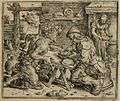
Marcus Gheeraerts the Elder, "The Satyr and the Peasant" from De warachtighe fabulen der dieren, 1567
-
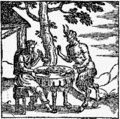
"The Satyr and the Traveller" in Geoffrey Whitney's Choice of Emblemes, Leiden, 1586
-

"The Satyr and the Traveller" from Iohannis Patousas' edition of Aesop's Fables in Greek, Venice, 1644
-
_2.jpg)
Wenceslas Hollar, "The Satyr and the Traveller" from John Ogilby's Aesop's Fables, 1660s
-

"The Satyre and the Clown" from Francis Barlow's edition of Aesop's Fables, 1687
Gallery 2a:Paintings from the Southern Netherlands
-

Jacob Jordaens, "The Satyr and the Peasant", Pushkin Gallery, Moscow, 1620s
-

Jacob Jordaens, "The Satyr and the Peasant", Staatliche Museen, Kassel, 1620s
-
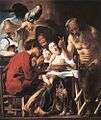
Jacob Jordaens, "The Satyr and the Peasant", Musées Royaux des Beaux-Arts, Brussels
-
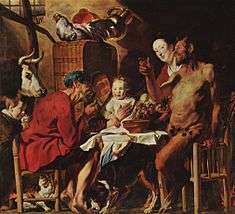
Jacob Jordaens, the laughing satyr variant
-

Jacob Jordaens, the peasant meal variant
-

Jan van de Venne, "The Satyr in the Peasant's House", Brukenthal National Museum, Sibiu Ro
-
Willem van Herp, "The Satyr and the Peasant",
-

Jan Cossiers, "The Satyr and the Peasant Family", National Gallery of Armenia, Yerevan
Gallery 2b:Paintings from the Northern Netherlands
-

Benjamin Gerritsz Cuyp, "The Satyr and the Peasant Family", first half of the 17th century
-
.jpg)
Wenceslas Hollar, a Dutch print of "The Satyr and the Peasant" dated 1649
-
Gerbrand van den Eeckhout, "The Satyr and the Peasant"
-

Moeyaert, a chalk drawing of "The Satyr and the Peasant"
-
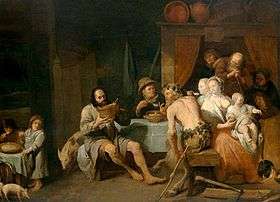
David Ryckaert the Younger, "The Satyr and the Peasant"
-
Barent Fabritius, "The Satyr and the Peasant", Musée des Beaux-Arts, Caen
-
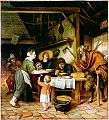
Jan Steen, "The Satyr and the Peasant", J. Paul Getty Museum, 1660/2
-

Jan Steen, "The Satyr and the Peasant", Museum Bredius, Den Haag NL, 1660s
Gallery 3: Paintings from Italy
-

Jan Lis, a Baroque treatment of "The Satyr and the Peasant", Venice, 1623/6
-

Sebastiano Ricci, "The Satyr and the Peasant", c.1700
-
Gaspare Diziani, "The Satyr and the Peasant", first half of the 18th century
Gallery 4: Illustrations of La Fontaine's Fable
-

Jean-Baptiste Oudry, "Le satyre et le passant" from the 1755 illustrated edition
-

Hippolyte Lecomte, "Le satyre et le passant" from the 1818 illustrated edition
-

Gustave Doré, "Le satyre et le passant" from the 1867 illustrated edition
-
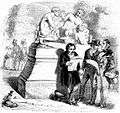
J.J. Grandville's reinterpretation of "Le satyre et le passant", 1838
References
- ↑ "Adages" (PDf). pp. 650–1.
- ↑ "113. DE FAUNO ET VIATORE. (Phryx Aesopus by Osius)".
- ↑ Imaginibus in aes incisis, notisque illustrata. Studio Othonis Vaeni ...
- ↑ Cento Favoli - morali de i piu illustri antichi & moderni autori Greci & Latini. p. 53.
- ↑ De warachtighe fabulen der dieren, 1567 see Hollar's copy in WikiCommons
- ↑ "Whitney 160".
- ↑ "74. De satyro et viatore (1687), illustrated by Francis Barlow".
- ↑ "An English translation". Retrieved 4 October 2014.
- ↑ "Fables from La Fontaine, in English verse".
- ↑ "Philosophical Dictionary, by Voltaire".
- ↑ Fables and epigrams; with essays on fable and epigram. From the German.
- ↑ http://cf.hum.uva.nl/dsp/ljc/vondel/1617/warande.html
- ↑ Cloutier-Blazzard, Kimberlee (2009). "The wise man has two tongues: images of the Satyr and Peasant by Jordaens and Steen". Myth in history, history in myth. Brill. pp. 87–90.
- ↑ Now in the Philadelphia Museum of Art. Retrieved 4 October 2014.
- ↑ Gabet, Charles (1834). Dictionnaire des artistes de l'école française au XIXe siècle. Paris. p. 297.
- ↑ Photo online
- ↑ The Court magazine and belle assemblee [afterw.] and monthly critic and the ... - Court magazine and monthly critic - Google Books.